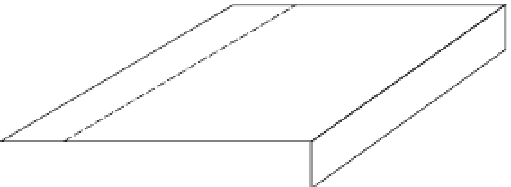Biomedical Engineering Reference
In-Depth Information
stream is quickly depleted, and the bulk of the cell bed is oxygenated via diffusion from the gas
phase. This leads to oxygen delivery that can be controlled independently of all other operating
variables and that is uniform. The gas phase composition can be used to control the oxygen
delivery. This is an example of how technology can be used to overcome some of the limitations
imposed by mass transfer considerations.
6.4.4 Fluid Flow and Uniformity
A device that carries tens of millions of microenvironments (i.e., a reconstituted tissue or
organ) must provide uniform delivery and removal of gases, nutrients, and growth factors.
Achieving such uniformity is difficult. This difficulty arises partly from the fact that fluid
has a no-slip condition as it flows past a solid surface. Thus, there will always be slower-
flowing regions close to any side walls in a bioreactor. These slow-flowing regions under
conditions of axial Graetz numbers of unity lead to mass transfer boundary layers that
extend beyond the hydrodynamic boundary layer.
This problem is illustrated further in Figure 6.32. Fluid is flowing down a thin slit, repre-
senting an on-end view of the chamber shown in Figure 6.33. Thin slits with high aspect
Region of non-uniform
concentration
Region of uniform
concentration
L
δ
m
X
Z
H
Y
W
Uniform flux from
bottom wall only
u
x
(y,z)
u
x
, flow velocity
H
C, c
o
ncentration of secreted protein
at the bottom of the chamber
x
z
y
Domain of interest, where fluid flow and
concentration distributions are uneven
FIGURE 6.32
Coordinate system for a rectangular chamber with production of biological factors secreted by
cells lodged on the bottom wall. The fluid is slowed down close to the side wall, creating a different concentration
than that found in the middle of the slit. This leads to a very different microenvironment for cell growth and devel-
opment of tissue function at the wall than elsewhere in the chamber.
From [15].



































































